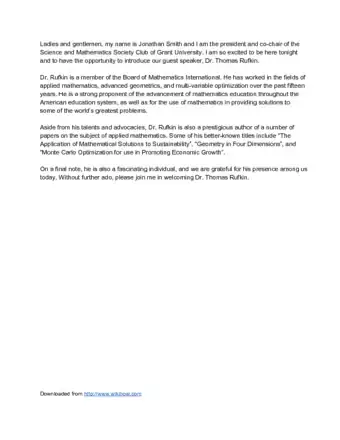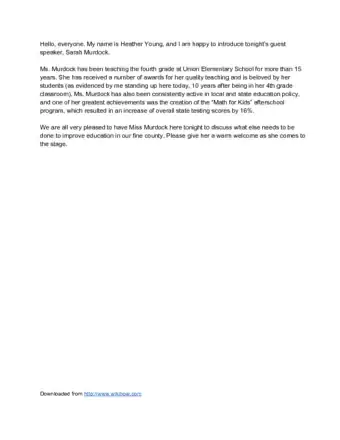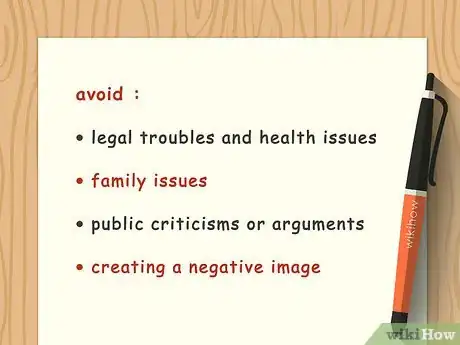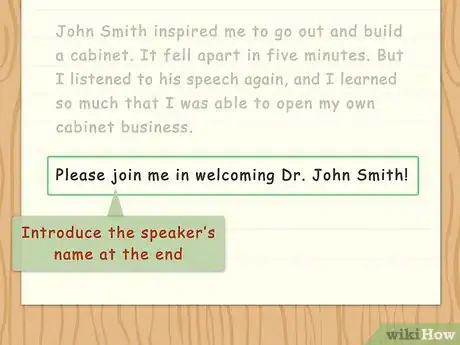This article was co-authored by Deb DiSandro and by wikiHow staff writer, Ali Garbacz. Deb DiSandro is the Owner of Speak Up On Purpose, an organization dedicated to improving and teaching public speaking. Deb has over 30 years of experience as a national speaker and has presented at the Erma Bombeck Writer’s Conference and the National Society of Newspaper Columnists. She was awarded the National Speakers Association Member of the Year 2007 and has been published in Writer's Digest, Daily Herald, Women's Day, and Better Homes & Gardens.
There are 8 references cited in this article, which can be found at the bottom of the page.
wikiHow marks an article as reader-approved once it receives enough positive feedback. In this case, several readers have written to tell us that this article was helpful to them, earning it our reader-approved status.
This article has been viewed 1,141,278 times.
Introducing a guest speaker is quite an honor. As the introducer, you get the audience excited about the talk they’re about to hear and play a crucial role in connecting the speaker to their audience on a more human level. Writing the perfect introduction speech requires some research and rehearsal on your part, but rest assured that you’ll be left with a speech that’ll leave your audience wanting more. Keep reading for our complete guide to writing the best introduction speech. Also, take a look at the samples we’ve included to get help you get started.
Things You Should Know
- Establish the guest speaker’s credibility by mentioning notable achievements and experiences that relate to the topic of their speech.
- Share a quick anecdote or surprising fact about the guest speaker to paint a picture of their personality and character.
- Get the audience excited for the upcoming presentation with a short sentence stating what the guest speaker will be talking about.
- Wait until the very end to introduce the guest speaker by their full name and title.
Steps
Sample Speeches
Researching the Speaker
-
1Ask the speaker what they’d like you to say. Many times, the speaker will have an introduction already prepared for you. If they don’t, talk with them directly to ask them what information they’d like for you to include in your speech. If the guest speaker isn’t available, talk to people who know them, such as mutual acquaintances or their coworkers.[1]
- When the speaker provides an introduction for you, use it. Read it over a few times and don’t hesitate to ask them for any clarification if you need it.
-
2Find out the speaker’s topic and who their audience is. As the introducer, it’s your job to give the audience a preview of the content they’re going to hear more about. Ask the speaker or event organizer about the topic and who the audience is. That way, you can tailor your tone and choose appropriate anecdotes for your introduction.[2]
- For example, if the speech is about encouraging young girls to learn computer programming, don’t spend time explaining how the speaker can teach these skills to adults.
- Additionally, if the audience is mostly people who work in the education field rather than computer programming, avoid using a lot of jargon specific to computer programming so the audience can follow along better.
Advertisement -
3Gather biographical information about the speaker. Search online for the speaker’s credentials, including things like their educational background, awards they’ve received, and any other notable achievements. Facts about their life outside of their work and their interests may also fit in your introduction.[3]
- Another method is to ask the speaker for their resume. Use this to pick out their most notable achievements to help establish their credibility.
- A good introduction goes beyond just reciting the speaker’s personal history. However, noting their most relevant and impressive achievements will help establish them as an authoritative figure to the audience.
-
4Avoid using sensitive or embarrassing information without approval. Remember that your introduction is meant to positively promote the speaker. Issues like legal troubles, health issues, or family issues can potentially create a negative image of the speaker. It’s not appropriate to bring up public criticisms or arguments others have made about the speaker.[4]
- Always get the speaker’s permission before using these details. If you need to use this information, have an explanation ready as to why it’s important to your introduction.
-
5Find other speeches the speaker has given. Look for information they give throughout that you can put into your introduction, such as anecdotes or other experiences they may not have put on their resume. If there’s an introduction, see what format and tone the introducer uses to talk about the speaker.[5]
- Be careful if you’re using pieces from another speech since it is copyrighted material and can’t be used without the speaker’s permission. Talk directly to the speaker about using these portions, or rephrase the section in your own words.
-
6Include a surprising detail if it works in your intro. Think about which details will make your audience even more engaged without distracting them from the main focus of the speech. This might be a detail that speaks well to the speaker’s character but isn’t well known. This is a good method to use to get the audience to laugh or put more focus on the speaker’s humanity For example:[6]
- “Many don’t know that John Doe originally went to school for law, but ended up choosing psychology instead. Just like many of you, he didn’t have much of an idea of where his life would take him. Little did he know that his legal studies would actually help him to become one of the most renowned therapists we know today.”
-
7Master pronouncing the speaker’s name. Taking the time to make sure you’re using the correct pronunciation is a great sign of respect for the speaker. Using improper pronunciation can make you look unprofessional. Contact the speaker directly or look for information online.[7]
-
8Check for any special titles the speaker uses. Addressing the speaker by their proper title is professional and gives the speaker more credibility. For example, refer to a doctor as Dr. Jane Doe and a judge as Judge Jane Doe. Additionally, be sure to also ask what pronouns the speaker uses (he/him, she/her, they/them, etc.).[8]
- Avoid using overly casual language to refer to the speaker, such as “guy,” “girl,” or “kid.” Instead, use “person,” “woman,” or “man.”
Writing the Introduction
-
1Keep the introduction under 1 minute. Remember that you are there to introduce the guest speaker and that your introduction is just the precursor to the main talk. Keep your piece to about 30 to 40 seconds, a minute at most. A few short paragraphs are usually enough to set the stage.[9]
-
2Explain the speaker’s qualifications that are relevant to the topic. This establishes the speaker’s credibility and authority. Examples of qualifications include publications, job experience, awards, and any success stories. Keep this section brief by choosing the most impactful accomplishments. For example:[10]
- “Jane’s passion for creative writing goes back to her high school days where she began the draft for her very first novel at the age of 15. By the time she was entering her sophomore year of college at 19 years old, she had already published her first book.”
- “John has received recognition and praise from some of the largest Fortune 500 companies for his dedication to creating curriculums to help strengthen teamwork in the workplace. He’s received multiple awards for his work and has even gone on to write a book sharing his unique insights and perspective.”
-
3Tell the audience what they’ll be learning from the speaker. It’s your job to capture the audience’s attention and get them excited about the upcoming presentation. Give them a concrete statement that lets them know what the speaker will be covering while keeping it vague enough to create some suspense. For example:[11]
- “Jane will tell you exactly how you can manifest every single one of your goals by making just five simple changes in your daily life.”
- “John is here today to share the secret to maximizing your savings so you can live freely without ever having to worry about finances again.”
-
4Include a short personal anecdote if you have one. Oftentimes, you’ll be chosen to speak because you have some kind of connection with the guest speakers. Even if you’re not best friends with the speaker, you might be close enough to have a couple of relevant stories to share. Through these anecdotes, you create a bridge between the audience and the guest speaker, helping the audience to warm up to their guest and trust them as an authoritative figure.[12]
- “John and I met a few years back and immediately bonded over the struggle of maintaining a healthy work-life balance. I’m sure many of us can relate to this.”
- “Jane’s book on navigating childcare in our current economy struck me at a very deep level. I’ve never read such relatable and honest words, and her work has given me comfort and reassurance during these unpredictable times.”
-
5Focus more on the speaker’s credibility rather than humor. Getting to the humorous parts of an anecdote can take up a lot of time and cause you to stray off topic. Of course, there are other instances where humor works well, especially if it’s a one or two-sentence anecdote that’s brief but contributes to your overall message. Use your best judgment when employing humor.[13]
- For example, you might say, “John Smith’s story working in the lumber industry inspired me to go out and build a cabinet. Unsurprisingly, it fell apart within five minutes of being built. I went back to him, and he was sure to reassure me that it’s a practice that requires much patience.”
-
6Introduce the speaker’s name at the end. If you mention the speaker’s name at the very beginning, there’s a chance your audience might forget it by the time you actually get to welcoming the speaker on stage. Mentioning the speaker’s full name and title near the end keeps your audience captivated and makes for a smooth transition into the main presentation. Some examples include:[14]
- “Please join me in welcoming Dr. John Smith!”
- “Here to discuss her newest book, “How to Live a Happier Life,” please give a warm welcome to Jane Doe.”
- “Here to share his unique perspective on the current political climate, please welcome Professor John Doe.”
-
7Read your speech aloud to catch any errors. After you’ve finished writing your speech, read it a couple of times out loud to check for any grammatical errors or sentences that sound odd. Pay attention to the overall tone of the speech and ask yourself if it’s fitting for the target audience. Also, time yourself to see if you fit in that 1-minute window.[15]
Delivering the Speech
-
1Practice your introduction multiple times. Spend adequate time rehearsing your speech before the event until your words come out fluidly and effortlessly. Some good practice methods include recording yourself and relistening to make critiques, or practicing in front of your friends or peers.[16]
- Also, practice using a friendly and relaxed tone when you give your speech to avoid coming off as super stiff and nervous.
- To overcome stage fright, recite the introduction while looking in a mirror. Once you feel comfortable, rehearse it in front of family and friends.
-
2Rehearse the introduction sparingly before going on stage. When you’re waiting for your moment, you’ll most likely want to go over the introduction again and again. A few rehearsals are totally fine but don’t wear yourself out by over-practicing. Instead, focus on relaxing and getting your energy up to introduce the guest speaker.[17]
-
3Introduce yourself when you begin. Stating your name and title is useful if someone in the room is unfamiliar with you. Keep this line short so you can get to the rest of the introduction. Remember that you’re setting the stage for the guest speaker, so there’s no need for a long explanation of who you are. If someone introduced you earlier, you can skip this.[18]
- For example, “Good evening. My name is Alex Brown, and I’m the organizer of this event.”
- If everyone in the audience is familiar with you, there’s no need to introduce yourself.
-
4Show lots of enthusiasm while speaking. Take a couple of deep breaths before starting, then be sure to give your audience a warm smile as you start speaking. Stand up straight, maintain eye contact with the audience members, and use hand gestures to make yourself look and feel more confident. Project your voice and inject lots of excitement to inspire the audience to pay attention to the guest speaker.[19]
-
5Speak loudly and clearly. Many speakers get nervous or overexcited which causes them to rush their words. Make a conscious effort to slow yourself down so that every part of your introduction is audible to the audience. Enunciate each word clearly and aim to have your voice project all the way to the back of the room.[20]
-
6Lead your audience in giving a warm welcome. After you’ve finished your introduction, be the first person to applaud and have the audience members follow your lead. Turn your body fully towards the speaker and give them a big, welcoming smile. Keep applauding until they reach you.[21]
-
7Shake the speaker’s hand. Shaking hands is a positive gesture that shows a bond between you and the speaker. Continue to face the speaker until they reach you on stage, then shake their hand.[22]
Expert Q&A
-
QuestionHow do I introduce a guest speaker in a classroom?
 Deb DiSandroDeb DiSandro is the Owner of Speak Up On Purpose, an organization dedicated to improving and teaching public speaking. Deb has over 30 years of experience as a national speaker and has presented at the Erma Bombeck Writer’s Conference and the National Society of Newspaper Columnists. She was awarded the National Speakers Association Member of the Year 2007 and has been published in Writer's Digest, Daily Herald, Women's Day, and Better Homes & Gardens.
Deb DiSandroDeb DiSandro is the Owner of Speak Up On Purpose, an organization dedicated to improving and teaching public speaking. Deb has over 30 years of experience as a national speaker and has presented at the Erma Bombeck Writer’s Conference and the National Society of Newspaper Columnists. She was awarded the National Speakers Association Member of the Year 2007 and has been published in Writer's Digest, Daily Herald, Women's Day, and Better Homes & Gardens.
Owner, Speak Up On Purpose Use a phrase like, "We have a special guest today, who I am excited to introduce you to." Of course, this all depends on the age of the students.
Use a phrase like, "We have a special guest today, who I am excited to introduce you to." Of course, this all depends on the age of the students. -
QuestionHow do I introduce more than one guest speaker?
 Deb DiSandroDeb DiSandro is the Owner of Speak Up On Purpose, an organization dedicated to improving and teaching public speaking. Deb has over 30 years of experience as a national speaker and has presented at the Erma Bombeck Writer’s Conference and the National Society of Newspaper Columnists. She was awarded the National Speakers Association Member of the Year 2007 and has been published in Writer's Digest, Daily Herald, Women's Day, and Better Homes & Gardens.
Deb DiSandroDeb DiSandro is the Owner of Speak Up On Purpose, an organization dedicated to improving and teaching public speaking. Deb has over 30 years of experience as a national speaker and has presented at the Erma Bombeck Writer’s Conference and the National Society of Newspaper Columnists. She was awarded the National Speakers Association Member of the Year 2007 and has been published in Writer's Digest, Daily Herald, Women's Day, and Better Homes & Gardens.
Owner, Speak Up On Purpose Give each person the same amount of time in the introduction. But, don't make your introduction long-winded. Just say less about each speaker.
Give each person the same amount of time in the introduction. But, don't make your introduction long-winded. Just say less about each speaker. -
QuestionMy guest speaker keeps insisting on introducing himself when I have been very clear that this cannot happen. How can I persuade him?
 Deb DiSandroDeb DiSandro is the Owner of Speak Up On Purpose, an organization dedicated to improving and teaching public speaking. Deb has over 30 years of experience as a national speaker and has presented at the Erma Bombeck Writer’s Conference and the National Society of Newspaper Columnists. She was awarded the National Speakers Association Member of the Year 2007 and has been published in Writer's Digest, Daily Herald, Women's Day, and Better Homes & Gardens.
Deb DiSandroDeb DiSandro is the Owner of Speak Up On Purpose, an organization dedicated to improving and teaching public speaking. Deb has over 30 years of experience as a national speaker and has presented at the Erma Bombeck Writer’s Conference and the National Society of Newspaper Columnists. She was awarded the National Speakers Association Member of the Year 2007 and has been published in Writer's Digest, Daily Herald, Women's Day, and Better Homes & Gardens.
Owner, Speak Up On Purpose If your speaker is a seasoned professional, listen to his reasons. He knows what he is doing. If he is new to speaking, you can explain that your introduction is meant to set him up for success. Then ask him what you can add to the introduction that will support this goal.
If your speaker is a seasoned professional, listen to his reasons. He knows what he is doing. If he is new to speaking, you can explain that your introduction is meant to set him up for success. Then ask him what you can add to the introduction that will support this goal.
References
- ↑ https://www.dacdb.com/Rotary/Accounts/5110/Downloads/30398/how-to-introduce-a-speaker.pdf
- ↑ https://www.press.umich.edu/pdf/9780472035090-unit1.pdf
- ↑ https://www.dacdb.com/Rotary/Accounts/5110/Downloads/30398/how-to-introduce-a-speaker.pdf
- ↑ http://canuwrite.com/speech_introduce.php
- ↑ http://canuwrite.com/speech_introduce.php
- ↑ http://www.write-out-loud.com/introduction-speech.html
- ↑ https://www.dacdb.com/Rotary/Accounts/5110/Downloads/30398/how-to-introduce-a-speaker.pdf
- ↑ https://www.press.umich.edu/pdf/9780472035090-unit1.pdf
- ↑ https://www.dacdb.com/Rotary/Accounts/5110/Downloads/30398/how-to-introduce-a-speaker.pdf
- ↑ https://www.press.umich.edu/pdf/9780472035090-unit1.pdf
- ↑ https://hbr.org/2016/10/how-to-memorably-introduce-another-speaker
- ↑ https://hbr.org/2016/10/how-to-memorably-introduce-another-speaker
- ↑ https://www.press.umich.edu/pdf/9780472035090-unit1.pdf
- ↑ https://www.dacdb.com/Rotary/Accounts/5110/Downloads/30398/how-to-introduce-a-speaker.pdf
- ↑ http://www.write-out-loud.com/introduction-speech.html
- ↑ http://www.write-out-loud.com/introduction-speech.html
- ↑ https://www.press.umich.edu/pdf/9780472035090-unit1.pdf
- ↑ https://westsidetoastmasters.com/resources/talk_your_way/ch15.html
- ↑ https://www.press.umich.edu/pdf/9780472035090-unit1.pdf
- ↑ https://www.press.umich.edu/pdf/9780472035090-unit1.pdf
- ↑ https://publicwords.com/2011/11/26/how-to-introduce-a-speaker-the-art-of-giving-and-receiving-a-great-introduction/
- ↑ http://www.publicwords.com/2011/11/26/how-to-introduce-a-speaker-the-art-of-giving-and-receiving-a-great-introduction/
About This Article
Before introducing your guest speaker, introduce yourself in case there are people in the audience who don't know you. Then talk about the speaker’s background and qualifications, and give the audience a high-level overview of what they might learn from the presentation. See if you can include a short, personal anecdote about the speaker, like "I read their book and really loved it," for example. Try to keep your introduction to less than 3 minutes, and finish it by welcoming your speaker and telling the audience their name. For more advice on introducing a guest speaker, including how to research them in advance, keep reading!
























































































